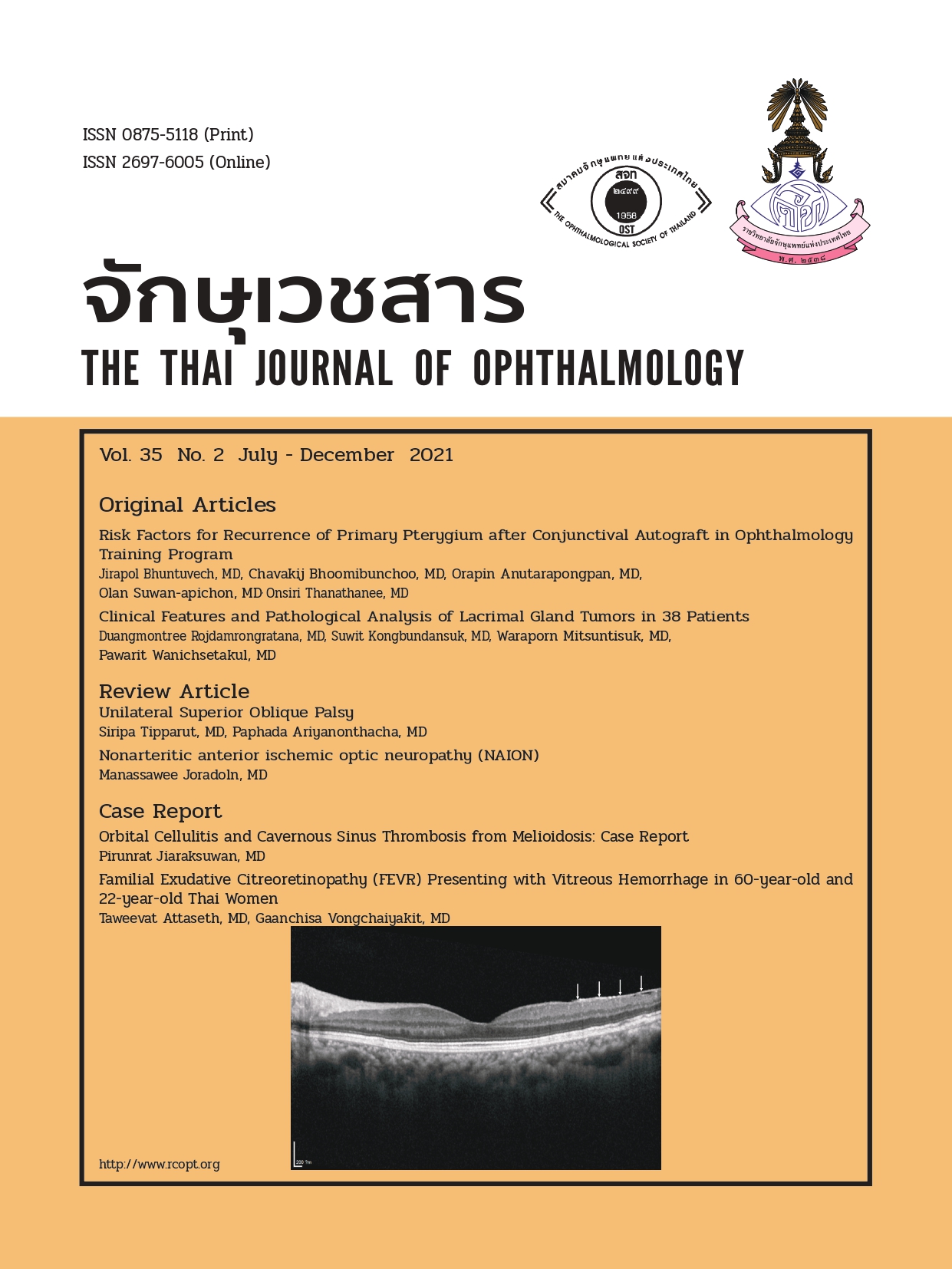ลักษณะทางคลินิกและผลการตรวจพยาธิวิทยาของเนื้องอกต่อมน้ำตาในผู้ป่วยจำนวน 38 ราย
คำสำคัญ:
เนื้องอกต่อมน้ำตา, มะเร็งต่อมน้ำเหลืองบทคัดย่อ
จุดประสงค์: การศึกษานี้ได้รวบรวมลักษณะทางคลินิกและผลตรวจพยาธิวิทยาของผู้ป่วยที่เข้ารับการรักษาทั้งหมด 38 ราย
วิธีการ: การศึกษานี้ได้รวบรวมข้อมูลผู้ป่วยย้อนหลังโดยศึกษาผู้ป่วยทั้งหมด 38 รายที่เป็นโรคเนื้องอกต่อมน้ำตา ซึ่งได้รับการ
รักษาที่โรงพยาบาลธรรมศาสตร์เฉลิมพระเกียรติ ในช่วงระยะเวลาตั้งแต่ มกราคม 2560 จนถึง ธันวาคม 2563 โดยได้เก็บรวบรวม
ข้อมูล เพศ อายุ อาการ อาการแสดง ภาพถ่ายทางรังสี รวมถึงลักษณะทางพยาธิวิทยา ไว้ทั้งหมด
ผลลัพธ์: จากผู้ป่วยทั้งหมด 38 รายพบว่า 12 ราย (31.58%) เป็นเพศชาย , 26 ราย (68.42%) เป็นเพศหญิง โดยพบว่าอายุอยู่
ในช่วงระหว่าง 11 ปี – 78 ปี อายุเฉลี่ยรวมอยู่ที่ 53 ปี คิดเป็นเนื้องอกชนิดไม่ร้ายแรง (benign) 23 ราย (60.53%) โดยแบ่งเป็นเป็น
ชนิด pleomorphic adenoma 2 ราย (5.26%), ชนิด IgG4-related disease 3 ราย (7.89%), ชนิด amyloidosis 1 ราย (2.63%),
ชนิด sarcoidosis 1 ราย (2.63%), ชนิด lymphoid hyperplasia 4 ราย (10.52%) และชนิด non-specific dacryoadenitis
11 ราย (28.95%) ซึ่งเป็นเนื้องอกชนิดไม่ร้ายแรงที่พบบ่อยที่สุด ส่วนผู้ป่วยกลุ่มที่เป็นมะเร็งต่อมน้ำตาที่เหลือคิดเป็นจำนวนทั้งหมด
15 ราย (39.47%) โดยเป็นชนิด adenocarcinoma 1 ราย (2.63%), มะเร็งเม็ดเลือดขาวชนิด acute myeloid leukemia 1 ราย
(2.63%), ชนิดมะเร็งต่อมน้ำเหลือง (lymphoma) 13 ราย (34.21%) ซึ่งถือได้ว่าเป็นมะเร็งต่อมน้ำตา (malignant) ที่พบบ่อยที่สุด
อาการที่เป็นสาเหตุให้ผู้ป่วยมาพบแพทย์บ่อยที่สุดคือ ก้อนที่บริเวณเปลือกตา พบในผู้ป่วย 37 ราย (97.37%), อาการตาโปนพบ 15
ราย (39.47%) และอาการปวดบริเวณรอบเบ้าตา 4 ราย (10.53%)
สรุป: เนื้องอกที่ต่อมน้ำตาส่วนใหญ่เป็นชนิดไม่ร้ายแรง โดยพบเนื้องอกชนิด non-specific dacryoadenitis มากที่สุด ซึ่งมัก
มาด้วยอาการสำคัญคือก้อนที่บริเวณเปลือกตา ส่วนเนื้องอกชนิดมะเร็งเป็นมะเร็งต่อมน้ำเหลืองมากที่สุด ส่วนใหญ่มาด้วยก้อนที่
บริเวณเปลือกตาเช่นเดียวกัน
เอกสารอ้างอิง
2. Tóth-Molnár E, Ding C. New insight into lacrimal gland function: Role of the duct epithelium in tear secretion. Ocul Surf. 2020 Oct;18(4):595-603.
3. von Holstein SL, Therkildsen MH, Prause JU, Stenman G, Siersma VD, Heegaard S. Lacrimal gland lesions in Denmark between 1974 and 2007. Acta Ophthalmol (Copenh). 2013 Jun;91(4):349-54.
4. Gündüz AK, Yeşiltaş YS, Shields CL. Overview of benign and malignant lacrimal gland tumors. Curr Opin Ophthalmol. 2018 Sep;29(5):458-68.
5. Andreasen S, Esmaeli B, Holstein SL von, Mikkelsen LH, Rasmussen PK, Heegaard S. An Update on Tumors of the Lacrimal Gland. Asia-Pac J Ophthalmol Phila Pa. 2017 Apr;6(2):159-72.
6. Olsen TG, Heegaard S. Orbital lymphoma. Surv Ophthalmol. 2019 Jan 1;64(1):45-66.
7. Lv M, Dong Z-J, Tong Y-X, Li T, Hei Y, Yang X-J, et al. Retrospective Analysis of Clinicopathological Characteristics of Lacrimal Gland Pleomorphic Adenoma and Mechanism of Tumorigenesis by the Imbalance Between Apoptosis and Proliferation.
Med Sci Monit Int Med J Exp Clin Res. 2021 Mar 19;27:e929152.
8. Teo L, Seah LL, Choo CT, Chee SP, Chee E, Looi A. A survey of the histopathology of lacrimal gland lesions in a tertiary referral centre. Orbit Amst Neth. 2013 Feb;32(1):1-7.
9. Ahn C, Kang S, Sa H-S. Clinicopathologic features of biopsied lacrimal gland masses in 95 Korean patients. Graefes Arch Clin Exp Ophthalmol Albrecht Von Graefes Arch Klin Exp Ophthalmol. 2019 Jul;257(7):1527-33.
10. Lai T, Prabhakaran VC, Malhotra R, Selva D. Pleomorphic adenoma of the lacrimal gland: is there a role for biopsy? Eye Lond Engl. 2009 Jan;23(1):2-6.
11. Lecler A, Zmuda M, Deschamps R. Infraorbital Nerve Involvement on Magnetic Resonance Imaging in Igg4-Related Ophthalmic Disease: A Highly Suggestive Sign. Ophthalmology. 2018 Apr;125(4):577. doi: 10.1016/j.ophtha.2017.12.025.
Erratum in: Ophthalmology. 2018 Jul;125(7):1127.
12. Soussan JB, Deschamps R, Sadik JC, Savatovsky J, Deschamps L, Puttermann M, Zmuda M, Heran F, Galatoire O, Picard H, Lecler A. Infraorbital nerve involvement on magnetic resonance imaging in European patients with IgG4-related ophthalmic disease: a specific sign. Eur Radiol. 2017 Apr;27(4):1335-1343. doi: 10.1007/s00330-016-4481- 5. Epub 2016 Jul 19.
13. Cheuk W, Yuen HKL, Chan ACL, Shih L-Y, Kuo T-T, Ma M-W, et al. Ocular adnexal lymphoma associated with IgG4+ chronic sclerosing dacryoadenitis: a previously undescribed complication of IgG4- related sclerosing disease. Am J Surg Pathol. 2008 Aug;32(8):1159-67.
ดาวน์โหลด
เผยแพร่แล้ว
ฉบับ
ประเภทบทความ
สัญญาอนุญาต
ลิขสิทธิ์ (c) 2021 จักษุเวชสาร

อนุญาตภายใต้เงื่อนไข Creative Commons Attribution-NonCommercial-NoDerivatives 4.0 International License.
The Thai Journal of Ophthalmology (TJO) is a peer-reviewed, scientific journal published biannually for the Royal College of Ophthalmologists of Thailand. The objectives of the journal is to provide up to date scientific knowledge in the field of ophthalmology, provide ophthalmologists with continuing education, promote cooperation, and sharing of opinion among readers.
The copyright of the published article belongs to the Thai Journal of Ophthalmology. However the content, ideas and the opinions in the article are from the author(s). The editorial board does not have to agree with the authors’ ideas and opinions.
The authors or readers may contact the editorial board via email at admin@rcopt.org.


